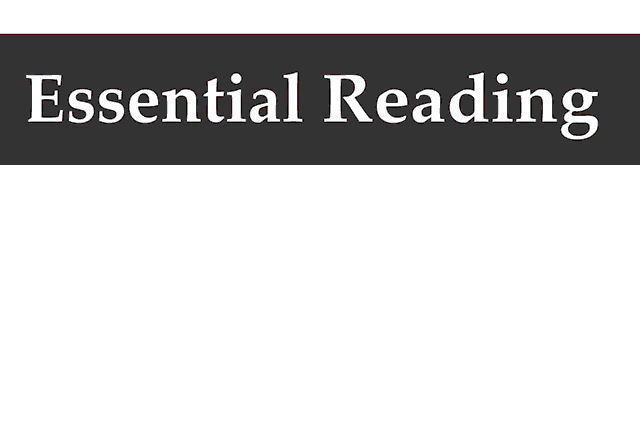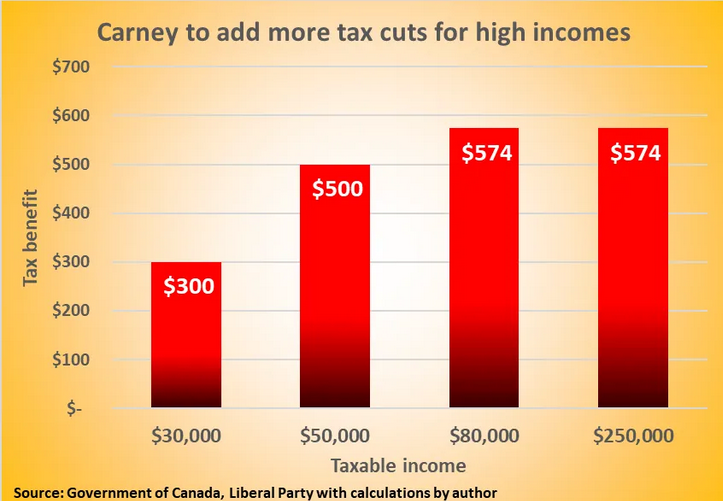March 24th, 2025
BURLINGTON, ON
No one’s ever accused Mark Carney of being middle class. But the former Toronto investment banker’s proposed “middle-class tax cut” includes ultra-high income earners like him.
The Liberal leader launched his campaign promising a “middle-class tax cut” that gives top benefits to millionaires and billionaires.
Carney’s plan would reduce the tax rate of the first tax bracket by one point, from 15 to 14 percent.
That generates a $574 benefit to anyone with a taxable income over $57,375 and right up to the top income earner. Those earning less than $57,375 would get a smaller benefit.
Unlike Trudeau in 2015, no high income offset with Carney
In 2015, Justin Trudeau also promised a “middle class” tax cut, but one that came with an off-setting tax increase on income over $250,000. That off-set cancelled any benefit once income exceeded about $263,000.
But with no offset in Carney’s plan, even the highest income earners in Canada are included in Carney’s “middle class” tax cut. The maximum $574 would be paid to Galen Weston, Chip Wilson, the Irvings, or the Thompson family. And Mark Carney.
Tax payable on a taxable income of $30,000 would be reduced by $300 and tax payable on $50,000 would fall $500.
While anything is helpful for low-income Canadians, bolder steps like the national dental care program deliver much more impact, saving a low-income family of four $1,809 a year, according to 2024 budget documents.
class=”header-anchor-post”>Carney kills planned tax hike on capital gains over $250,000 a year
Today’s pledged tax cut for even the richest Canadians comes after Carney cancelled Trudeau’s plan for two-thirds of capital gains over $250,000 a year to become subject to income tax, up from half. Half of the amounts up to $250,000 a year would continue to go tax-free.
Capital gains are the amount earned from buying then selling capital assets, such as company stock, and are treated differently than employment income in tax law.
In recent research paper in Policy Options, tax experts using 2019 tax filer information found the entire benefit of Carney’s cancellation would flow to just 46,705, or 0.16 percent, of tax filers. That group had an average income of $1,183,157 in 2019.
For 99.86 percent of Canada’s 29 million tax filers, there would be no benefit from Caney’s tax cancellation.
In 2027-2028, cancelling capital gains changes is projected to be worth $1.8 billion to that very small pool or investors earning more than $250,000 a year in capital gains. The amount saved is projected to rise to $2.3 billion in 2028-29.
Carney will get “middle class tax cut,” but benefit from cancelling capital gains unclear
On starting at the Bank of England in 2013, Carney was being paid $1.4 million a year. Seven years later, Carney left to join Brookfield Asset Management, an investment bank with $1 trillion in assets that owns everything from privatized hospitals to local utilities and real estate.
Carney served as Brookfield board chair, resigning January 16, 2025.
Last week, a US corporate filing by Brookfield Asset Management shows Carney and two other executives together earned $4 million in salary, $3.5 million in cash bonuses and $67,439 paid to retirement savings contributions and Brookfields’ executive medical program.
The $7,567,439 total, if averaged between the three executives, would be $2,522,479 each.
Despite his ultra-high income, Mark Carney has included himself in his “middle-class tax cut.”
Brookfields’ 10-K filing also shows Carney held 409,300 Brookfield share options on December 31, 2024. On Friday’s close, Brookfield stock traded at $53.65. But Carney’s options let him buy those shares for the deeply discounted price of $37.54.
If Carney exercised any share options on Friday, he would’ve earned $16.11 per share, the difference between the $53.65 market price and the $37.54 option price. If he exercised all his 409,300 share options on Friday, he would have earned $6,598,823.
While stock option income is usually treated as a capital gain, and therefore only half taxed, earnings from stock options received as employment compensation are employment income and must all be included as income. However, the employee stock option benefit deduction parallels the capital gains inclusion rate, delivering the same effect, a detailed topic for a future date.



















I better watch what I say more carefully, like about PPCon this morning, here in another story. It seems from this story here, that all politicians, including Carney, don’t seem to be able to be openly honest. I agree that including the millionaires and billionaires is not anything like the middle-class in the impacts on the families. The high end don’t have any comparative impact at all.
However, to me, PPCon is in his own world of extreme talk of Canadian doom, and complex promises to fix everything without a plan to justify. That is his problem to me. He really needs to tone it down – it all sounds so phony.
I disagree with his or his cabinet decision to not go ahead with the revisions to the Capital Gains Tax revision……appeasing our oligarch rich perhaps. They are NOT middleclass.
We must protect our billionaires, who are becoming an endangered species in Canada.
Mark Carney is Justin Trudeau’s Liberal government policies with a different head. He has surrounded himself with the same old cabinet members that were loyal to Trudeau.
It is also interesting to note that while Mr. Carney says he got rid of the carbon tax that is indeed not quite the truth. To get rid of the carbon tax this can only be done through legislation.
What Mark Carney did in his photo-op signing was simply reduce the rate of the carbon tax to 0% for now. He could increase this at any time should he become the next elected Prime Minister.